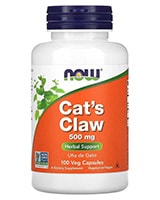

Introduction
Cat’s Claw, scientifically known as Uncaria tomentosa, is a vine that originates from the rainforests of South America. This herb has garnered attention in the realm of natural health remedies due to its diverse range of medicinal properties. Historically, it has been used by indigenous cultures for healing and disease prevention. In recent years, scientific research has begun to validate many of these traditional uses, revealing a variety of health benefits.
1. Boosts the Immune System
Cat’s Claw is renowned for its ability to enhance the immune system’s functionality. Studies have shown that it can increase the production of white blood cells[1]Farias, I., Araujo, M. do C., Zimmermann, E. S., Dalmora, S. L., Benedetti, A. L., Alvarez-Silva, M., … Schetinger, M. R. C. (2011). Uncaria tomentosa stimulates the proliferation of myeloid progenitor cells. Journal of Ethnopharmacology, 137(1), 856–863. https://doi.org/10.1016/j.jep.2011.07.011, which play a crucial role in the body’s defence against pathogens. This enhancement of the immune response is particularly beneficial in combating infections and can contribute to overall health and well-being. The herb’s immune-boosting properties are attributed to its unique alkaloids and other phytochemicals that stimulate the immune system.
2. Anti-inflammatory Properties
The anti-inflammatory properties of Cat’s Claw are among its most significant health benefits. This herb has been shown to reduce inflammation, making it a valuable natural remedy for conditions such as arthritis and other inflammatory diseases[2]Hardin, S. R. (2007). Cat’s claw: An Amazonian vine decreases inflammation in osteoarthritis. Complementary Therapies in Clinical Practice, 13(1), 25–28. https://doi.org/10.1016/j.ctcp.2006.10.003. Clinical studies have demonstrated its efficacy in reducing joint pain and swelling, particularly in cases of osteoarthritis and rheumatoid arthritis. The compounds within Cat’s Claw, including glycosides and tannins, are believed to be responsible for these anti-inflammatory effects.
3. Antioxidant Effects
Cat’s Claw is rich in antioxidant compounds, which are crucial in combating oxidative stress and free radical damage in the body[3]Sandoval, M., Okuhama, N. N., Zhang, X.-J., Condezo, L. A., Lao, J., Angeles, F. M., Musah, R. A., Bobrowski, P., & Miller, M. J. S. (2002). Anti-inflammatory and antioxidant activities of cat’s claw (Uncaria tomentosa and Uncaria guianensis) are independent of their alkaloid content. Phytomedicine, 9(4), 325-337. https://doi.org/10.1078/0944711032110117. These antioxidants play a vital role in preventing cellular damage, which is a precursor to many chronic diseases, including heart disease and cancer. The specific antioxidants in Cat’s Claw, such as polyphenols and flavonoids, contribute to its ability to neutralize harmful free radicals, thereby offering protective benefits against oxidative stress.
4. Supports Joint Health
The herb’s efficacy in supporting joint health is particularly notable. Cat’s Claw has been used effectively to alleviate symptoms associated with joint conditions, such as osteoarthritis and rheumatoid arthritis. Clinical research indicates that regular consumption of Cat’s Claw can lead to significant reductions in joint pain and stiffness, enhancing mobility and quality of life for individuals suffering from these conditions[4]Hardin, S. R. (2007). Cat’s claw: An Amazonian vine decreases inflammation in osteoarthritis. Complementary Therapies in Clinical Practice, 13(1), 25–28. https://doi.org/10.1016/j.ctcp.2006.10.003. Its therapeutic effects are attributed to its anti-inflammatory and immune-modulating properties, which are essential in managing joint health.
5. Promotes DNA Repair
One of the more remarkable benefits of Cat’s Claw is its potential to aid in DNA repair. This aspect is crucial for maintaining cellular health and preventing mutations that could lead to cancer. Scientific studies have indicated that certain compounds in Cat’s Claw can enhance the body’s natural ability to repair damaged DNA[5]Mammone, T., Akesson, C., Gan, D., Giampapa, V., & Pero, R. W. (2006). A water soluble extract from Uncaria tomentosa (Cat’s Claw) is a potent enhancer of DNA repair in primary organ cultures of human skin. Phytotherapy Research, 20(3), 178–183. https://doi.org/10.1002/ptr.1827. This property not only contributes to cancer prevention but also plays a role in the longevity and overall health of the body’s cells.
6. Cognitive Health Benefits
Emerging research suggests that Cat’s Claw may have significant benefits for cognitive health[6]Snow, A. D., Castillo, G. M., Nguyen, B. P., Choi, P. Y., Cummings, J. A., Cam, J., … Larsen, L. (2019). The Amazon rain forest plant Uncaria tomentosa (cat’s claw) and its specific proanthocyanidin constituents are potent inhibitors and reducers of both brain plaques and tangles. Scientific Reports, 9, 561. https://doi.org/10.1038/s41598-019-38645-0. It has been studied for its potential in neuroprotection and its ability to improve cognitive functions, including memory and focus. This makes it a subject of interest in the prevention and management of neurodegenerative diseases like Alzheimer’s. The alkaloids and other phytochemicals in Cat’s Claw are believed to protect the brain from oxidative stress and inflammation, which are key factors in cognitive decline.
7. Gastrointestinal Benefits
Cat’s Claw has traditionally been used to treat various gastrointestinal issues. Its anti-inflammatory properties are beneficial in managing conditions such as gastritis, ulcers, and intestinal inflammation. Research supports its use in promoting digestive health, with studies indicating its effectiveness in reducing gastrointestinal inflammation and aiding in the healing of digestive tract injuries[7]Coakley, H. (2023, November 08). Cat’s Claw Benefits and Safety. Verywell Health. Retrieved from https://www.verywellhealth.com/cats-claw-benefits-and-safety-8379773. The compounds in Cat’s Claw help soothe irritated digestive systems, making it a valuable herbal remedy for maintaining gastrointestinal health.
How Cat’s Claw Works
Understanding the mechanisms behind Cat’s Claw’s health benefits involves examining its active compounds. The herb contains a range of biologically active constituents, including oxindole alkaloids, polyphenols, and flavonoids[8]Kaiser, S., Verza, S. G., Moraes, R. C., Pittol, V., Peñaloza, E. M. C., Pavei, C., & Ortega, G. G. (2013). Extraction optimization of polyphenols, oxindole alkaloids and quinovic acid glycosides from cat’s claw bark by Box–Behnken design. Industrial Crops and Products, 48, 153-161. https://doi.org/10.1016/j.indcrop.2013.04.026. These compounds interact synergistically within the body, contributing to its immune-boosting, anti-inflammatory, and antioxidant effects. They work by modulating various biological pathways, such as reducing the production of pro-inflammatory cytokines and enhancing DNA repair mechanisms. This multifaceted action is what makes Cat’s Claw a potent and versatile natural remedy.
Safety and Dosage
When considering the use of Cat’s Claw, it is important to be aware of its safety profile and appropriate dosage. Generally, Cat’s Claw is considered safe when consumed in recommended amounts. However, as with any supplement, there can be potential side effects, such as gastrointestinal discomfort, headaches, or dizziness, particularly at higher doses. Pregnant or nursing women should avoid Cat’s Claw due to insufficient research on its safety in these populations. Additionally, individuals with autoimmune diseases or those on immunosuppressant drugs should consult a healthcare provider before use, as Cat’s Claw stimulates the immune system.
The recommended dosage of Cat’s Claw varies depending on the form of the supplement and the health condition being addressed. For general health purposes, doses of 250 to 350 mg per day are commonly used. In cases of specific health conditions like arthritis or gastrointestinal disorders, higher dosages may be recommended under medical supervision. It is crucial to follow the dosage instructions on supplement labels or the advice of a healthcare professional.
Conclusion
Cat’s Claw is a remarkable herb with a wide spectrum of health benefits. From boosting the immune system to promoting joint health and cognitive function, it offers various therapeutic properties. Its ability to act as an antioxidant and anti-inflammatory agent, along with its potential in DNA repair and gastrointestinal health, makes it a valuable addition to natural health practices. While it is generally safe, understanding the correct dosage and potential interactions is essential. As with any supplement, consulting with a healthcare provider before incorporating Cat’s Claw into your health regimen is advisable. This ensures its safe and effective use, tailored to individual health needs and conditions.
Buy Cat’s Claw Online Review Comparison Table
 Cat's Claw | iHerb | 100 pills (500 mg) | $7.33 |  Worldwide, AU | Visit Website >> |
References
| ↑1 | Farias, I., Araujo, M. do C., Zimmermann, E. S., Dalmora, S. L., Benedetti, A. L., Alvarez-Silva, M., … Schetinger, M. R. C. (2011). Uncaria tomentosa stimulates the proliferation of myeloid progenitor cells. Journal of Ethnopharmacology, 137(1), 856–863. https://doi.org/10.1016/j.jep.2011.07.011 |
|---|---|
| ↑2, ↑4 | Hardin, S. R. (2007). Cat’s claw: An Amazonian vine decreases inflammation in osteoarthritis. Complementary Therapies in Clinical Practice, 13(1), 25–28. https://doi.org/10.1016/j.ctcp.2006.10.003 |
| ↑3 | Sandoval, M., Okuhama, N. N., Zhang, X.-J., Condezo, L. A., Lao, J., Angeles, F. M., Musah, R. A., Bobrowski, P., & Miller, M. J. S. (2002). Anti-inflammatory and antioxidant activities of cat’s claw (Uncaria tomentosa and Uncaria guianensis) are independent of their alkaloid content. Phytomedicine, 9(4), 325-337. https://doi.org/10.1078/0944711032110117 |
| ↑5 | Mammone, T., Akesson, C., Gan, D., Giampapa, V., & Pero, R. W. (2006). A water soluble extract from Uncaria tomentosa (Cat’s Claw) is a potent enhancer of DNA repair in primary organ cultures of human skin. Phytotherapy Research, 20(3), 178–183. https://doi.org/10.1002/ptr.1827 |
| ↑6 | Snow, A. D., Castillo, G. M., Nguyen, B. P., Choi, P. Y., Cummings, J. A., Cam, J., … Larsen, L. (2019). The Amazon rain forest plant Uncaria tomentosa (cat’s claw) and its specific proanthocyanidin constituents are potent inhibitors and reducers of both brain plaques and tangles. Scientific Reports, 9, 561. https://doi.org/10.1038/s41598-019-38645-0 |
| ↑7 | Coakley, H. (2023, November 08). Cat’s Claw Benefits and Safety. Verywell Health. Retrieved from https://www.verywellhealth.com/cats-claw-benefits-and-safety-8379773 |
| ↑8 | Kaiser, S., Verza, S. G., Moraes, R. C., Pittol, V., Peñaloza, E. M. C., Pavei, C., & Ortega, G. G. (2013). Extraction optimization of polyphenols, oxindole alkaloids and quinovic acid glycosides from cat’s claw bark by Box–Behnken design. Industrial Crops and Products, 48, 153-161. https://doi.org/10.1016/j.indcrop.2013.04.026 |

Leave a Reply